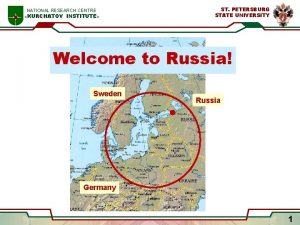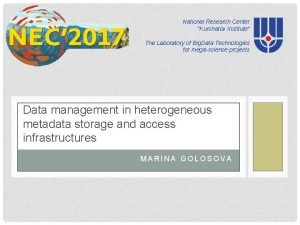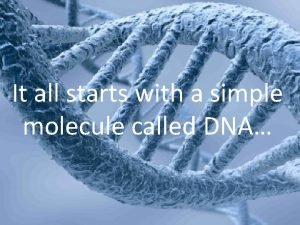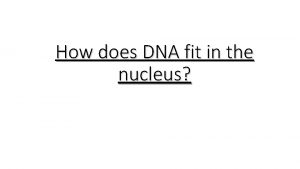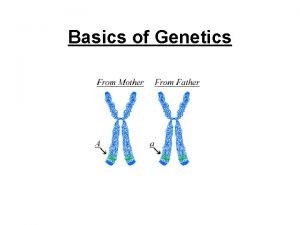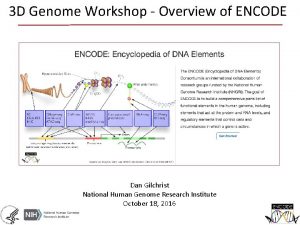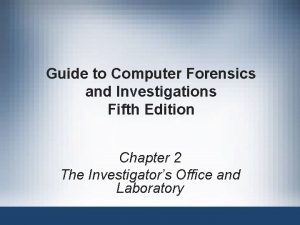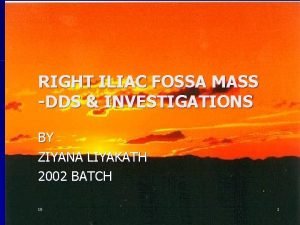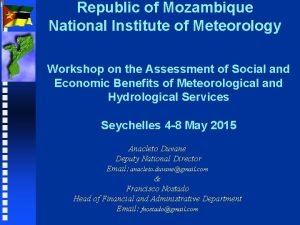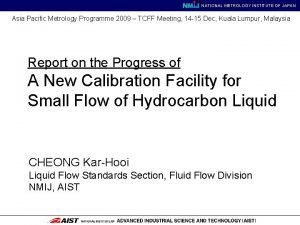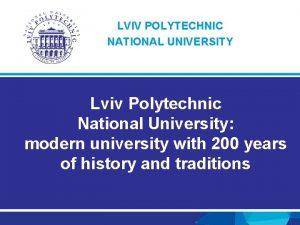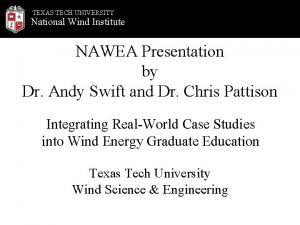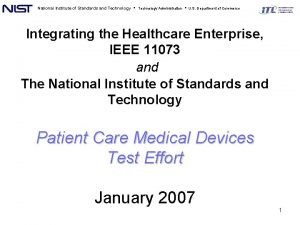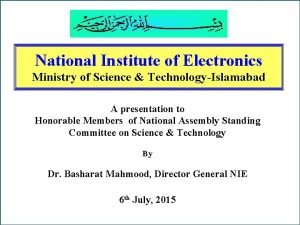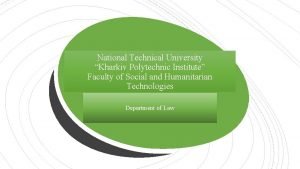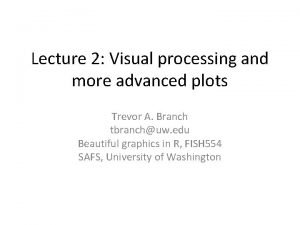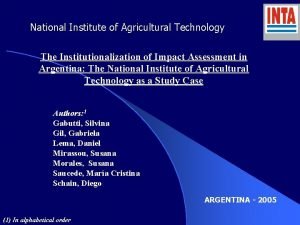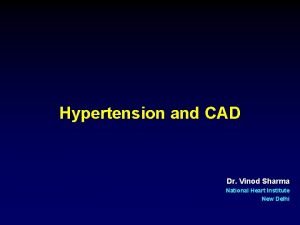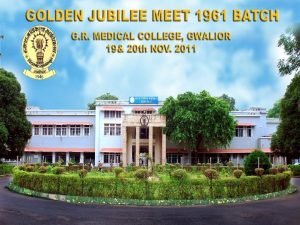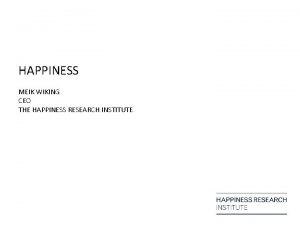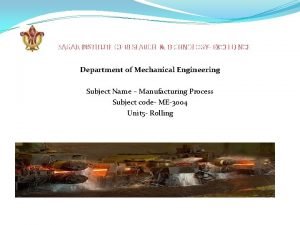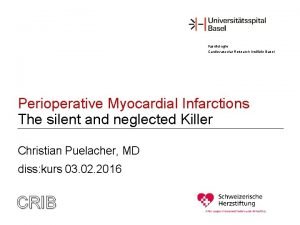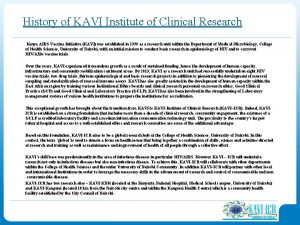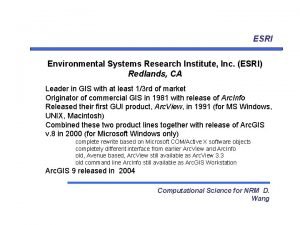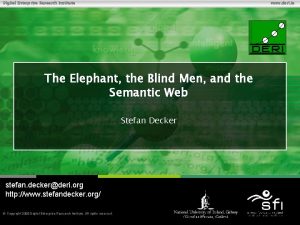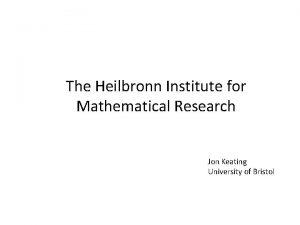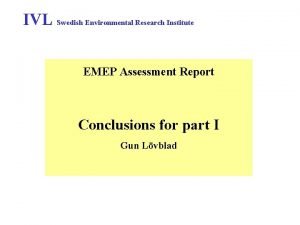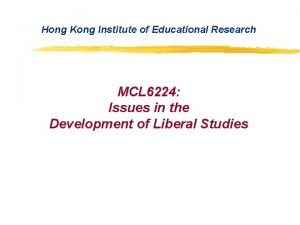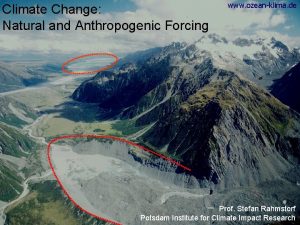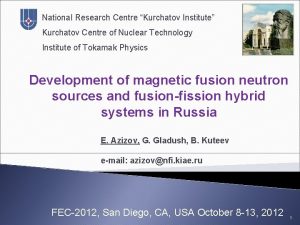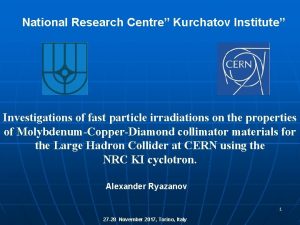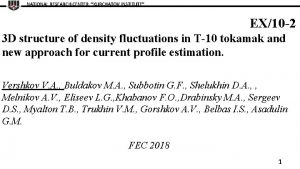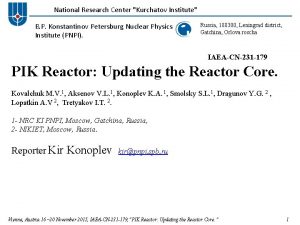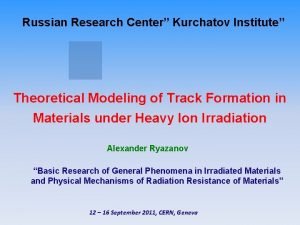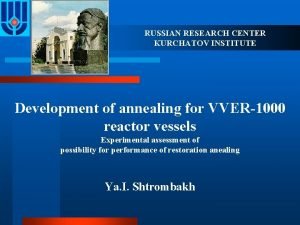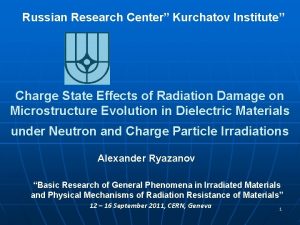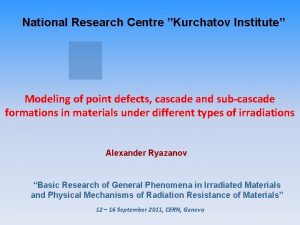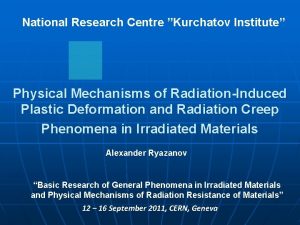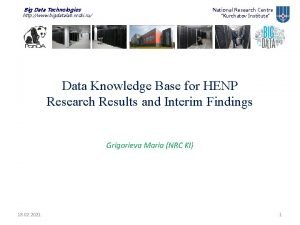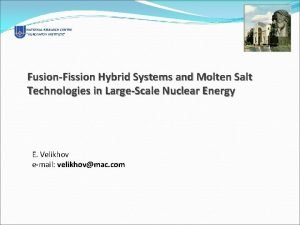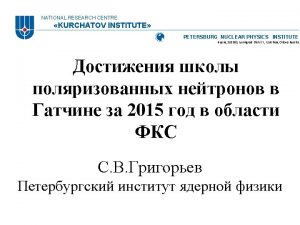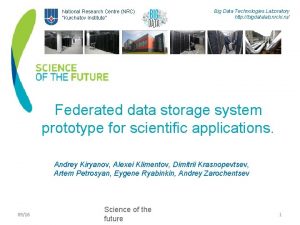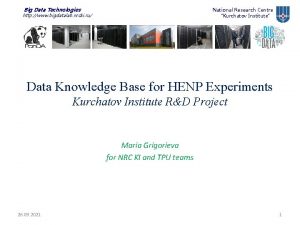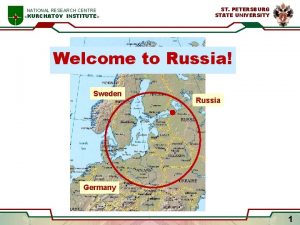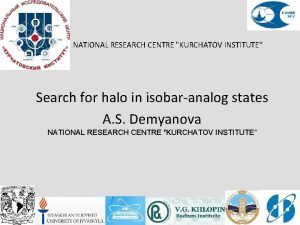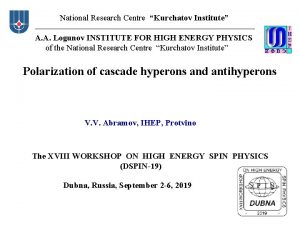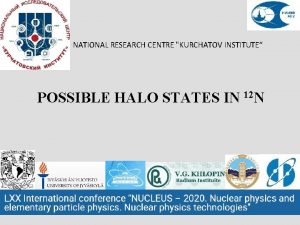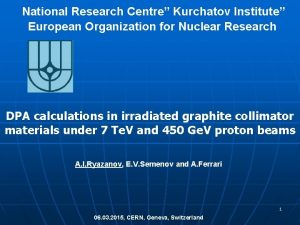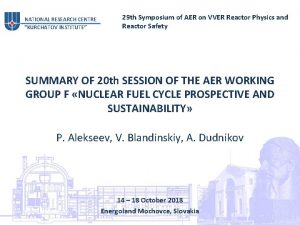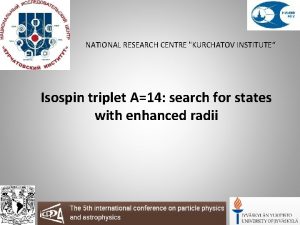National Research Center Kurchatov Institute Investigations of fast


























































![The bright field (BF) High resolution (HRTEM) image of a diamond in B=[001] zone The bright field (BF) High resolution (HRTEM) image of a diamond in B=[001] zone](https://slidetodoc.com/presentation_image/60cf6830a9f7f3820993621360e4a167/image-59.jpg)
![The bright field (BF) High resolution (HRTEM) image of a diamond in B=[112] zone The bright field (BF) High resolution (HRTEM) image of a diamond in B=[112] zone](https://slidetodoc.com/presentation_image/60cf6830a9f7f3820993621360e4a167/image-60.jpg)


















- Slides: 78

National Research Center” Kurchatov Institute” Investigations of fast proton irradiation effects on Mo-Diamond collimator materials for LHC at NRC “Kurchatov Institute” and comparison with the results for Co-Diamond materials. Alexander Ryazanov 1 8 August 2014, CERN, Switzerland

cyclotron System of cyclotron transportation 8 August 2014, CERN, Switzerland

Accelerators of Charge Particles at National Research Centre “Kurchatov Institute” n Cyclotron of NRC KI: protons with energy < 35 Me. V, current J < 30 mk. A helium ions He 4 with energy < 60 Me. V, current J < 20 mk. A ions O 16 with energy < 120 Me. V , current J < 5 mk. A ions C 12 with energy < 80 Me. V, current J < 5 mk. A 8 August 2014, CERN, Switzerland

Microstructure of Mo - diamond sample surface under different magnification (-200 (a) and -500 (b)) made on optical microscope Carl Zeiss Axio Observer D 1 m Cu 4 8 August 2014, CERN, Switzerland

STEM Study of Cu-diamond composite diamond Cu 5

The SEM study and sample preparation Diamonds Cu SEM (secondary electrons -SE) images of the Cu-diamond composite 6 18 February 2013, CERN, Switzerland

Theoretical modelling of radiation damage profiles (dpa) in Cu-Diamond and Mo-Cu. Diamond materials irradiated by fast protons on NRC KI cyclotron with the energy up to 35 Me. V 7 8 August 2014, CERN, Switzerland

Theoretical modeling of point radiation damage accumulation in Mo-Diamond and Cu-Diamond materials irradiated by 30 Me. V protons p Cu, Mo. Cu ρ (Cu) = 8. 94 g/cm 3 , Diam Ed(Cu) = 30 e. V Ed(Diam) = 50 e. V 1) L(Diam) = 130 μm, L(Cu) = 65 μm 2) L(Diam) = 100 μm, L(Cu) = 50 μm 8 August 2014, CERN, Switzerland 8

Physical parameters used for numerical calculations in two theoretical models in both materials Cu. CD and Mo. Cu. CD Material Cu. CD (layered) Mo. Cu. CD (layered) Layer thikness, microns Ed, e. V Density, g/cm 3 130 (CD) 50 3. 373 65 (Cu) 30 8. 94 45 (CD) 50 3. 373 45 (Mo. Cu) 50 9. 581 Cu. CD (average) - 30/50 (Cu/CD) 5. 4 Mo. Cu. CD (average) - 50 6. 7 8 August 2014, CERN, Switzerland

Ranges of protons in Cu. CD layered structure of two different layer configurations versus proton energy 10 8 August 2014, CERN, Switzerland

Ranges of protons in Cu. CD material with average density as a function of proton energy 11 8 August 2014, CERN, Switzerland

Radiation damage profiles from protons with energy 5 Me. V in the layered structure of Cu. CD material for two different configurations of layers 12 8 August 2014, CERN, Switzerland

Radiation damage profiles from protons with energy 5 Me. V in the layered structure of Cu. CD material for two different configurations of layers 13 8 August 2014, CERN, Switzerland

Distribution of radiation damage profiles (dpa) in Mo-Cu-Diamond irradiated by protons with the energy 5 Me. V at fluence Ф =1017 p/cm 2 14 8 August 2014, CERN, Switzerland

Dependence of penetration depth of fast protons in Copper-Diamond Samples on proton energy <ρ(Cu-D)> = 5. 4 g/cm 3 , 16 8 August 2014, CERN, Switzerland

Displacement damage profiles in Copper-Diamond irradiated by 30 Me. V protons up to dose Ф = 1 x 10 E 17 p/cm 2 17 8 August 2014, CERN, Switzerland

Displacement damage profiles in Copper-Diamond irradiated by 30 Me. V protons up to dose Ф = 1 x 10 E 18 p/cm 2 18 8 August 2014, CERN, Switzerland

Displacement damage profiles in Copper-Diamond irradiated by 30 Me. V protons up to dose Ф = 1 x 10 E 17 p/cm 2 19

Displacement damage profiles in Copper-Diamond irradiated by 30 Me. V protons up to dose Ф = 1 x 10 E 18 p/cm 2 20

Ranges of protons in Mo. Cu. CD layered structure of two different layer configurations versus proton energy 21 8 August 2014, CERN, Switzerland

Radiation damage profile from protons with energy 5 Me. V in the layered structure of Mo. Cu. CD material for two different configurations of layers 22 8 August 2014, CERN, Switzerland

Radiation damage profile from protons with energy 5 Me. V in the layered structure of Mo. Cu. CD material for two different configurations of layers 23 8 August 2014, CERN, Switzerland

Radiation damage profile from protons with energy 30 Me. V in the layered structure of Mo. Cu. CD material for a dose up to 1017 p/cm 2 24 8 August 2014, CERN, Switzerland

Radiation damage profile from protons with energy 30 Me. V in Mo. Cu. CD material with average density for a dose up to 1017 p/cm 2 25 8 August 2014, CERN, Switzerland

Radiation damage profiles from carbon ions with energy 26 -80 Me. V in copper for a dose up to 10 E 17 ion/cm 2 26 8 August 2014, CERN, Switzerland

Radiation damage profile from carbon with energy 26 -80 Me. V in copper for a dose up to 10 E 18 ion/cm 2 27 8 August 2014, CERN, Switzerland

Radiation damage profiles from carbon ions with energy 26 -80 Me. V in diamond for a dose up to 10 E 17 ion/cm 2 28 8 August 2014, CERN, Switzerland

Radiation damage profiles from carbon ions with energy 26 -80 Me. V in diamond for a dose up to 10 E 18 ion/cm 2 29 8 August 2014, CERN, Switzerland

Radiation damage profiles from carbon ions with energy 80 Me. V in the layered structure of Cu. CD material for two different configurations of layers. 30 8 August 2014, CERN, Switzerland

Radiation damage profile from carbon ions with energy 80 Me. V in the layered structure of Cu. CD material for two different configurations of layers. 31 8 August 2014, CERN, Switzerland

Conclusion • On the basis of the proposed theoretical models of the layered structure for the irradiated materials, a number of calculations have been performed to determine radiation damage profiles. • Calculations show that the damage levels in diamond inclusions approximately an order of magnitude lower than that of copper and molybdenum-copper alloy. • The average damage for both irradiated materials correspond to 10 -4 dpa for diamond inclusions and 10 -3 dpa for copper and copper-molybdenum alloy under irradiation of 30 Me. V protons to doses 1017 p/cm 2. • Calculations carried out with the average density approach correspond to values about 3*10 -4 dpa. The ranges of protons for the materials with the layered structure and with the average density coincide within the margin of error for protons with energies greater than 10 Me. V. • Irradiation of samples with carbon ions leads to a higher levels of displacements, but the ranges of 80 Me. V carbon ions are limited with 70 microns. The average damage is generally distributed within individual layers of copper or diamond and it may vary significantly for carbon ions passing the interface between diamond inclusions and metal. 32 8 August 2014, CERN, Switzerland

Development of experimental methods for investigations of physical-mechanical properties in Mo - Diamond collimator materials before and after fast proton irradiation with the energy 30 Me. V 33 8 August 2014, CERN, Switzerland

Determination of the density in Mo - Diamond samples before and after 30 Me. V proton beam irradiation on NRC KI cyclotron up to dose 10 E 17 p/cm 2 Sample, shape Weight, g Sizes, mm D=10, 115 H=4, 225 D=10, 00 H=4, 185 D=10, 225 H=4, 505 О-1, cylinder 2, 225/2, 254* О-2, cylinder 2, 093/2, 090 О-3, cylinder 2, 515/2, 485 Р-1, Parallepepid 1, 918/1, 903 L=16, 0 Р-2, Parallepepid -/1, 982 L=16, 0 Р-3, Parallepepid 1, 970/1, 944 L=16, 0 Density change, Hydrostatic density, d, g/cm 3 (dобл-dисх)/dисх, % 6, 569/6, 585 0, 2 6, 285/6, 289 0, 1 6, 745/6, 681 - 0, 9 6, 686/6, 737 0, 2 6, 686/6, 705 0, 3 6, 665/6, 668 0, 0 * - before, * - after irradiation

Sizes of Mo-Diamond samples for mechanical tests based on ASTM C 1161 02 c and ASTM D 6272– 02 Standards before and after (*) proton irradiation Sample, № h, mm b, mm h*, mm b*, mm L, mm 1) S, mm 2 S*, mm 2 ΔS/S, % Mo-Cu-D-1 4, 40 5, 68 4, 41 5, 70 ~61 24, 96 25, 12 0, 6 Mo-Cu-D-2 4, 50 5, 92 4, 18 5, 32 ~61 26, 62 26, 82 0, 7 Mo-Cu-D-3 4, 43 5, 71 4, 36 5, 38 ~60 25, 27 25, 26 0, 0 h-height, b-width and L-length 35 8 August 2014, CERN, Switzerland

Results of mechanical tests of Mo-Diamond samples before and after (*) 30 Me. V proton irradiation on NRC KI cyclotron № Sample FM(E), FM(E)*, N N σE, МPа σE*, МPа ЕB, GPа ЕB*, GPа ((ЕИ*EИ)/ ЕИ)∙ 10 0, % Mo-Cu-D-1 100 50 34, 2 17, 1 158± 8 184± 9 16 Mo-Cu-D-2 100 50 31, 2 15, 6 179± 8 210± 9 17 Mo-Cu-D-3 100 50 33, 8 16, 9 155± 9 180± 8 16 FM(E), (N)- maximum applied load, σE, (МPа) – obtained maximum stress before rupture EB, EB * - Young’s Modulus of elasticity of pure bending 36 of non-irradiated and (*) irradiated samples, respectively.

Young’s Modulus changes in Cu-Diamond materials before and after 30 Me. V proton irradiation using four points pure deformation (bending) according ASTM C 1161 -02 c Standard Маркировка/Назначение FM, N σf. B, МPа ЕИ, GPA (Unirradiated) ЕИGPA (Irradiated) % (difference) М-18 (before) 241, 5 90 272 39 - - М-18 (before) 413, 6 127 - - - М-20/ (before) 241, 2 86 224 17 - - М-16/ (Before and after Irradiation) 101, 7 35 240 52 338 28 41 М-22/ (Before and after Irradiation) 101, 4 38 241 22 308 19 28 М-24 (Before and after Irradiation) 101, 6 39 230 19 343 31 49 Young’s Modulus changes in Cu-Diamond materials after 30 Me. V proton irradiation are higher (39%) comparing with Mo-Diamond materials (16%) 37 8 August 2014, CERN, Switzerland

Deformation curves for irradiated (*) by 30 Me. V protons and unirradiated Mo-Diamond samples for LHC collimator materials after proton irradiation before irradiation 38 8 August 2014, CERN, Switzerland

Deformation curves for irradiated by 30 Me. V protons and unirradiated Cu-Diamond materials after proton irradiation before irradiation 39 8 August 2014, CERN, Switzerland

Dependence of deformation curves in outer fibers of Mo. Cu. D on applied stress for unirradiated (♦, ■, ●) and irradiated by 30 Me. V protons (◊, □, ○) during measurements of Young’s Modulus of elasticity 40 8 August 2014, CERN, Switzerland

Temperature dependence of thermal expansion coefficient in Mo-Diamond collimator material (Sample P 1) 41

Temperature dependence of thermal expansion coefficient in Cu-Diamond collimator material (Sample P 7) In Cu-D is higher comparing with Mo-D 42

Measurements of thermal expansion coefficient in Cu-Diamond collimator materials after 30 Me. V proton beam irradiation at T =100ºC on NRC KI cyclotron up to dose 10 E 17 p/cm 2 43 8 August 2014, CERN, Switzerland

Comparison of thermal expansion physical coefficient (α) in Cu-Diamond collimator materials before and after 30 Me. V proton beam irradiation at T =100ºC on NRC KI cyclotron up to dose 10 E 17 p/cm 2 Т measurement, о. С 50 100 120 α ineatial, 1/К, 10 -6 7, 8 8, 5 9, 0 α irradiated, 1/К, 10 -6 8, 3 9, 0 10, 9 The increasing of TEC (α) is equal 5 -7 % 44

Temperature dependence of thermal expansion coefficient in Mo-Diamond collimator materials 100 200 300 αисх, 10 -6 1/К 400 500 Cu. Diamond 9, 0 9, 7 10, 4 12, 2 Mo. Cu. Diamond (Sample P 1) 7, 5 8, 1 8, 4 8, 3 7, 4 Mo. Cu. Diamond (Sample P 2) 8, 1 8, 2 8, 5 8, 1 7, 7 Mo. Cu. Diamond (Sample P 3) 8, 3 8, 5 9, 0 8, 7 7, 6 Т, о. С 45 8 August 2014, CERN, Switzerland

Temperature dependence of thermal expansion coefficient in irradiated by 30 Me. V protons and dose 10 E 17 1/cm 2 Mo-Diamond collimator material (Sample P 1) 46 8 August 2014, CERN, Switzerland

Temperature dependence of thermal expansion coefficient in irradiated by 30 Me. V protons and dose 10 E 17 1/cm 2 Mo-Diamond collimator material (Sample P 2) 47 8 August 2014, CERN, Switzerland

Temperature dependence of thermal expansion coefficient in irradiated by 30 Me. V protons and dose 10 E 17 1/cm 2 Mo-Diamond collimator material (Sample P 3) 48 8 August 2014, CERN, Switzerland

Temperature dependence of thermal expansion coefficient in Mo-Diamond collimator materials Т, о. С 20 50 Unirradiated Sample 1 Sample 2 Sample 3 120 7, 5 8, 1 8, 3 α, 10 -6 1/К Irradiated Sample 1 100 α, 10 -6 1/К (growth) 6, 02 4, 40 7, 74 6, 36 7, 33 8, 72 7, 70 7, 49 8, 11 8, 23 7, 26 7, 36 Thermal expansion coefficient in Mo-Diamond materials after 30 Me. V proton irradiation is less comparing with unirradiated material 49 8 August 2014, CERN, Switzerland

Measurements of electrical resistivity in Mo-Diamond collimator materials before and after 30 Me. V proton beam irradiation on NRC KI cyclotron up to dose 10 E 17 p/cm 2 Sample I II III Condition Initial Irradiated Initial Irradiated ρ, 10 -6, Оm·m 110 142 85 113 (ρirr - ρin) /ρin, % 29 33 Initial Irradiated 91 137 51 The increasing of ER in Mo-D after proton irradiation is larger (37, 7%) 50 8 August 2014, CERN, Switzerland

Measurements of electrical resistivity in Cu-Diamond collimator materials before and after 30 Me. V proton beam irradiation on NRC KI cyclotron up to dose 10 E 17 p/cm 2 Sample I II III Condition Initial Irradiated Initial Irradiated ρ, 10 -6, Оm·m 9, 0 8, 8 10, 2 (ρirr- ρin) /ρin, % -2 0 Initial Irradiated 10, 1 10, 5 4 The increasing of ER in Cu-D after proton irradiation is negligible 51 8 August 2014, CERN, Switzerland

TEM study of Mo - Diamond composite 52 8 August 2014, CERN, Switzerland

sample preparation Cross-sectional samples for TEM were prepared by focus ion beam (FIB) in the Helios (FEI, US) dual-beam electron-ion microscope. The Ga+ ions energy during sample prep was 30 ke. V in the beginning and 2 ke. V at the end of the procedure. Tarnsmission electron microscopy/Scanning transmission electron microscopy (TEM/STEM) TEM/STEM study were performed in TITAN 80 -300 TEM/STEM (FEI, US) operated at 300 k. V and equipped with Cs probe corrector system, energy dispersive X-ray spectrometer (EDXS) (EDAX, US), electron energy loss spectroimeter (EELS), (Gatan. US) and high angle annular dark field (HAADF) detector 53 (Fischione, US)

The Scanning Electron Microscopy (SEM) study of Mo –Diamond composite 54 8 August 2014, CERN, Switzerland

The Scanning Electron Microscopy (SEM) study of Mo –Diamond composite 55 8 August 2014, CERN, Switzerland

The Scanning Electron Microscopy (SEM) study of Mo–Diamond composite Diamonds Mo SEM (secondary electrons -SE) images of the Mo-diamond composite 56 8 August 2014, CERN, Switzerland

The SEM study Diamonds Mo SEM (secondary electrons -SE) images of the Mo - diamond 57 composite 8 August 2014, CERN, Switzerland

The STEM and microanalysis (EDXS) study 1 3 2 1 3 µm The Dark field (HAADF - High angle annular dark field) STEM image of the sample and results of EDXS analysis The microanalysis results demonstrated that left part of sample was diamond and right part –Mo-Cu alloy. The brighter areas corresponds to Mo and darker to Cu. 2 3 58

The STEM and microanalysis (EDXS) study 1 3 1 2 2 3 3 µm The HAADF STEM mage of the sample and results of EDXS analysis 59
![The bright field BF High resolution HRTEM image of a diamond in B001 zone The bright field (BF) High resolution (HRTEM) image of a diamond in B=[001] zone](https://slidetodoc.com/presentation_image/60cf6830a9f7f3820993621360e4a167/image-59.jpg)
The bright field (BF) High resolution (HRTEM) image of a diamond in B=[001] zone axis and Fast Fourier Transform 111 -111 0. 203 nm 60 8 August 2014, CERN, Switzerland
![The bright field BF High resolution HRTEM image of a diamond in B112 zone The bright field (BF) High resolution (HRTEM) image of a diamond in B=[112] zone](https://slidetodoc.com/presentation_image/60cf6830a9f7f3820993621360e4a167/image-60.jpg)
The bright field (BF) High resolution (HRTEM) image of a diamond in B=[112] zone axis and Electron diffraction 111 220 61

Development of experimental methods for investigations of mechanical properties in Molybdenum-Copper - Diamond collimator materials before and after fast proton irradiation with the energy 30 Me. V up to dose 10 E 17 1/cm 2 62 8 August 2014, CERN, Switzerland

Elastic modulus tests Development of methodology for elastic modulus tests were conducted on high-density graphite samples (MPG 6), by comparing quantities of graphite elastic modulus, measured in a variety of three ways: 1) dynamic method, 2) axial compression method with an add-on detector, 3) tests on a four-point bend with measuring deformation on traverse displacement. 63 8 August 2014, CERN, Switzerland

Elastic modulus measurement by pure bending Elastic modulus calculation by pure bending was conducted in accordance with ASTM D 6272– 02 standard for the applied facility: where - elastic modulus, MPa; m - inclination of the initial straight-line portion of loading curve, N/mm; l - distance between lower bearings, mm (see pic. 4. 1); b, h - samples’ breadth and height, accordingly, mm; 64 8 August 2014, CERN, Switzerland

Equipment for measurements Young’s Modulus changes before and after 30 Me. V proton irradiation using four points pure deformation (bending) according ASTM C 1161 -02 c. standard Load Sample Indicator Basis 65 8 August 2014, CERN, Switzerland

Mo – Cu - Diamond sample sizes Sample № h, mm b, mm L, mm 1) 1 4, 40 5, 68 ~61 2 4, 50 5, 92 ~60 3 4, 43 5, 71 ~60 Samples were not polished and had a surface due to production technique; Sample № FM(E), N σf, MPa ЕИ, GPa 1 101, 7 34, 7 157, 9± 8, 4 2 101, 7 31, 9 178, 7± 8, 4 3 101, 7 34, 1 155, 1± 8, 5 FM(E) - maximum load applied to the sample in the process of testing, σf – achieved tensions in the process of testing for measuring ЕИ; ЕИ – Flexural (elastic) modulus measured by pure bending. 8 August 2014, CERN, Switzerland 66

Curves «load – deflection» of «Mo - Cu-Diamond» material samples by measuring elastic modulus 67 8 August 2014, CERN, Switzerland

Measurements of temperature dependence of thermal diffusivity in Mo-Diamond collimator materials before proton irradiation on NRC KI cyclotron 68 8 August 2014, CERN, Switzerland

Measurements of temperature dependence of thermal diffusivity in Cu-Diamond collimator materials before proton irradiation on NRC KI cyclotron Sample Р 2 -1 -1 Sample Р 2 -1 -2 Sample Р 2 -1 -3 69 8 August 2014, CERN, Switzerland

Measurements of temperature dependence of thermal diffusivity in Mo-Diamond collimator materials before proton irradiation during heating from 200ºС up to 800ºС 70 8 August 2014, CERN, Switzerland

First heating Second heating after cooling 71 8 August 2014, CERN, Switzerland

Measurements of temperature dependence of thermal diffusivity in Mo-Diamond collimator materials before proton irradiation during heating from 30ºС up to 800ºС First heating Second heating after cooling 72 8 August 2014, CERN, Switzerland

Measurements of temperature dependence of thermal diffusivity in Mo-Diamond collimator materials before and after 30 Me. V proton irradiation on NRC KI cyclotron with dose 10 E 17 1/cm 2 irradiated unirradiated 73 8 August 2014, CERN, Switzerland

Eu. CARD-2 74 8 August 2014, CERN, Switzerland

Col. Mat-HDED collaboration and beyond • Col. Mat-HDED partners • Partnership agreement with CERN (KN 2045) • Collaboration CERN with US-LARP Desy – May ‘ 14

WP 11 (and beyond) detailed work • Eu. CARD 2 WP 11 Col. Mat-HDED focusses on further material developments for collimators and targets: – Producing novel material samples (Brevetti-Bizz, RHP, CERN) – Performing irradiation tests in M-branch (from 2011 in GSI) and Hi. Rad. Mat (from 2012 at CERN), together with well-established irradiation facilities (NRC-KI and BNL) to measure radiation resistance and hardness. (CERN, GSI, UM, KUG, IFIC) – Characterising mechanical properties (POLITO and CERN). – Simulating mechanical properties (POLITO, NRC-KI, GSI, UM and CERN) and beam induced damage (CERN). – Simulating radiation induced damage (NRC-KI, GSI and CERN). – Integrating collimators into beam environment to give specifications and validate (CERN, HUD, UNIMAN, RHUL, IFIC). Desy – May ‘ 14

WP 11 results and next • Heavy ion irradiation tests at GSI (C, Xe, Au, Bi, U, Pb-ions up to 1. 15 Ge. V) • Proton and C irradiation tests at NRC-KI (up to 35 Me. V and 80 Me. V). • Proton irradiation tests (up to 200 Me. V) at BNL. • Planned proton irradiation tests at Hi. Rad. Mat (CERN)( up to 450 Ge. V) • Thermo-mechanical tests at POLITO. • Material sample measurements at CERN. Desy – May ‘ 14

Suggestions in the frame of Eu. CARD 2: Development of theoretical models and performing of numerical calculations of effect of fast particles (protons, heavy ion) on behavior of LHC collimator materials. • Calculations of radiation damage profiles in collimator materials: Cu. CD, Mo. Gr for protons with energy up to 200 Me. V (BNL, NRC KI), up to 450 Ge. V (CERN) and heavy ions up to 1 Ge. V (GSI). • Calculations of temperature distribution profiles in irradiated collimator materials Cu. CD, Mo. CD under fast protons with energy up to 200 Me. V (BNL, NRC KI), up to 450 Ge. V (CERN) and heavy ions up to 1 Ge. V (GSI). • Calculations of shock waves in collimator materials under proton irradiation with 450 Ge. V and 7 Te. V taking into account “ Thermal Spike” and “Coulomb Explosion” models. 78 8 August 2014, CERN, Switzerland

Thank you very much to S. Redaelli and A. Bertarelli for many scientific discussions and all for your attention ! 79 8 August 2014, CERN, Switzerland
 National research center kurchatov institute
National research center kurchatov institute National research center kurchatov institute
National research center kurchatov institute Assistive technology implementation plan sample
Assistive technology implementation plan sample National human genome research institute
National human genome research institute National human genome research institute
National human genome research institute Translation
Translation Encode
Encode National research institute of brewing
National research institute of brewing Swedish national road and transport research institute
Swedish national road and transport research institute Non acid fast bacteria
Non acid fast bacteria Acid fast and non acid fast bacteria
Acid fast and non acid fast bacteria National center for scientific research demokritos
National center for scientific research demokritos National research center for career and technical education
National research center for career and technical education Npcrc
Npcrc Why aren t descriptive investigations repeatable
Why aren t descriptive investigations repeatable Nrich maths investigations
Nrich maths investigations Private investigator craigslist
Private investigator craigslist Guide to computer forensics and investigations 6th edition
Guide to computer forensics and investigations 6th edition Numerical datum crossword puzzle clue
Numerical datum crossword puzzle clue Types of statistical investigation
Types of statistical investigation Forensic science fundamentals and investigations chapter 6
Forensic science fundamentals and investigations chapter 6 Toledo bmv heatherdowns
Toledo bmv heatherdowns Observations in scientific method
Observations in scientific method Pasco county cpi
Pasco county cpi Chs investigations
Chs investigations Guide to computer forensics and investigations 5th edition
Guide to computer forensics and investigations 5th edition Right iliac fossa mass investigations
Right iliac fossa mass investigations Jarrod bowditch
Jarrod bowditch 3 weeks pregnant ultrasound
3 weeks pregnant ultrasound Investigations
Investigations Forensics
Forensics Chs investigations
Chs investigations Spike unist internship
Spike unist internship Mozambique national institute of meteorology
Mozambique national institute of meteorology Toshiba 1b japanasia
Toshiba 1b japanasia Lviv polytechnic university
Lviv polytechnic university National wind institute
National wind institute National institute on drug abuse
National institute on drug abuse National institute of standards and technology
National institute of standards and technology National food service management institute
National food service management institute National electronics complex of pakistan (necop)
National electronics complex of pakistan (necop) Regulatory agencies
Regulatory agencies National technical university kharkiv polytechnic institute
National technical university kharkiv polytechnic institute Xkcd 1080
Xkcd 1080 National institute of statistics romania
National institute of statistics romania National institute of agricultural technology
National institute of agricultural technology National institute of agricultural botany
National institute of agricultural botany Ranipril
Ranipril Dr adarsh kumar national heart institute
Dr adarsh kumar national heart institute Bcc geospatial center of the cuny crest institute
Bcc geospatial center of the cuny crest institute Australian primary health care research institute
Australian primary health care research institute Telethon institute for child health research
Telethon institute for child health research Croatian forest research institute
Croatian forest research institute Where is happiness
Where is happiness Bill harris centerpointe
Bill harris centerpointe Primary control vs secondary control
Primary control vs secondary control Samsung biomedical research institute
Samsung biomedical research institute Sagar institute of research and technology
Sagar institute of research and technology Cardiovascular research institute basel
Cardiovascular research institute basel Kavi institute of clinical research
Kavi institute of clinical research Environmental systems research institute inc
Environmental systems research institute inc Electronics and telecommunications research institute
Electronics and telecommunications research institute Digital enterprise research institute
Digital enterprise research institute Jon keating oxford
Jon keating oxford Target institute of medical education and research
Target institute of medical education and research World research institute
World research institute Environmental systems research institute
Environmental systems research institute International institute of health management research
International institute of health management research Prof ram meghe institute of technology and research
Prof ram meghe institute of technology and research Korea automobile testing & research institute
Korea automobile testing & research institute Kncap test protocol
Kncap test protocol Ivl swedish environmental research institute
Ivl swedish environmental research institute Hong kong institute of educational research
Hong kong institute of educational research The potsdam institute for climate impact research
The potsdam institute for climate impact research Cfa research challenge report template
Cfa research challenge report template Institute for urban policy research
Institute for urban policy research Commerce development research institute
Commerce development research institute Sproel
Sproel Electric power research institute
Electric power research institute
